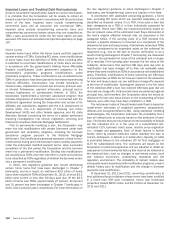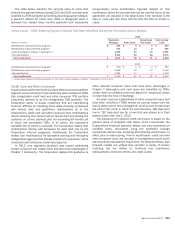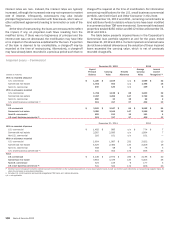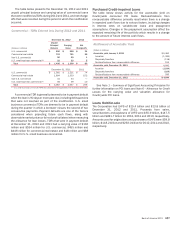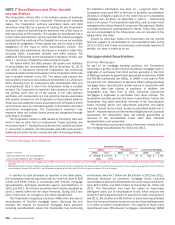Bank of America 2012 Annual Report Download - page 195
Download and view the complete annual report
Please find page 195 of the 2012 Bank of America annual report below. You can navigate through the pages in the report by either clicking on the pages listed below, or by using the keyword search tool below to find specific information within the annual report.
Bank of America 2012 193
The table below presents the carrying value of loans that
entered into payment default during 2012 and 2011 and that were
modified in a TDR during the 12 months preceding payment default.
A payment default for home loan TDRs is recognized when a
borrower has missed three monthly payments (not necessarily
consecutively) since modification. Payment default on trial
modification where the borrower has not yet met the terms of the
agreement are included in the table below if the borrower is 90
days or more past due three months after the offer to modify is
made.
Home Loans – TDRs Entering Payment Default That Were Modified During the Preceding Twelve Months
2012
(Dollars in millions)
Residential
Mortgage Home Equity
Discontinued
Real Estate
Total Carrying
Value
Modifications under government programs $200 $8$ 2 $ 210
Modifications under proprietary programs 933 14 9 956
Loans discharged in Chapter 7 bankruptcy (1) 1,216 53 12 1,281
Trial modifications 2,323 20 28 2,371
Total modifications $ 4,672 $ 95 $ 51 $ 4,818
2011
Modifications under government programs $ 350 $ 2$ 2 $ 354
Modifications under proprietary programs 2,086 42 12 2,140
Trial modifications 1,094 17 7 1,118
Total modifications $ 3,530 $ 61 $ 21 $ 3,612
(1) Includes loans classified as TDRs at December 31, 2012 due to loans discharged in Chapter 7 bankruptcy in 2012 or 2011.
Credit Card and Other Consumer
Impaired loans within the Credit Card and Other Consumer portfolio
segment consist entirely of loans that have been modified in TDRs
(the renegotiated credit card and other consumer TDR portfolio
collectively referred to as the renegotiated TDR portfolio). The
Corporation seeks to assist customers that are experiencing
financial difficulty by modifying loans while ensuring compliance
with federal laws and guidelines. Substantially all of the
Corporation’s credit card and other consumer loan modifications
involve reducing the interest rate on the account and placing the
customer on a fixed payment plan not exceeding 60 months, all
of which are considered TDRs. In all cases, the customer’s
available line of credit is canceled. The Corporation makes loan
modifications directly with borrowers for debt held only by the
Corporation (internal programs). Additionally, the Corporation
makes loan modifications for borrowers working with third-party
renegotiation agencies that provide solutions to customers’ entire
unsecured debt structures (external programs).
In 2012, new regulatory guidance was issued addressing
certain consumer real estate loans that have been discharged in
Chapter 7 bankruptcy. The Corporation applies this guidance to
other secured consumer loans that have been discharged in
Chapter 7 bankruptcy, and such loans are classified as TDRs,
written down to collateral value and placed on nonaccrual status
no later than the time of discharge.
All credit card and substantially all other consumer loans that
have been modified in TDRs remain on accrual status until the
loan is either paid in full or charged off, which occurs no later than
the end of the month in which the loan becomes 180 days past
due or 120 days past due for a loan that was placed on a fixed
payment plan after July 1, 2012.
The allowance for impaired credit card loans is based on the
present value of projected cash flows, which incorporates the
Corporation’s historical payment default and loss experience on
modified loans, discounted using the portfolio’s average
contractual interest rate, excluding promotionally priced loans, in
effect prior to restructuring. Prior to modification, credit card and
other consumer loans are included in homogeneous pools which
are collectively evaluated for impairment. For these portfolios, loss
forecast models are utilized that consider a variety of factors
including, but not limited to, historical loss experience,
delinquencies, economic trends and credit scores.









